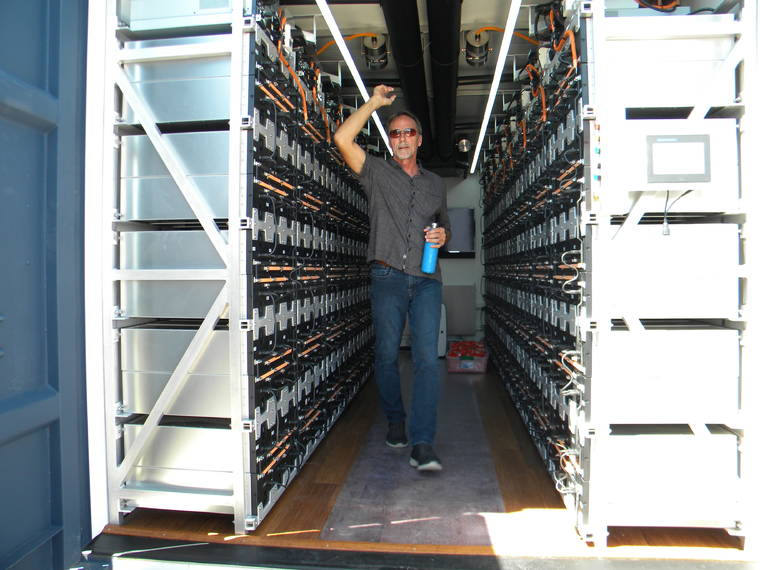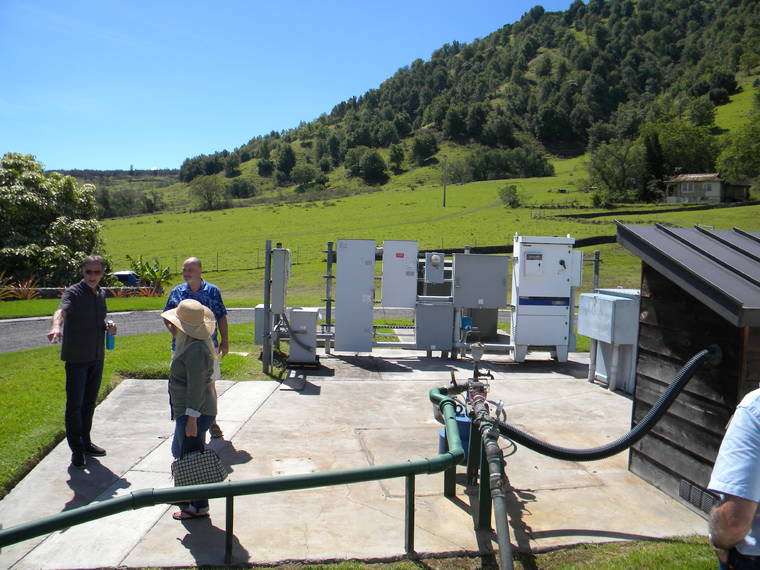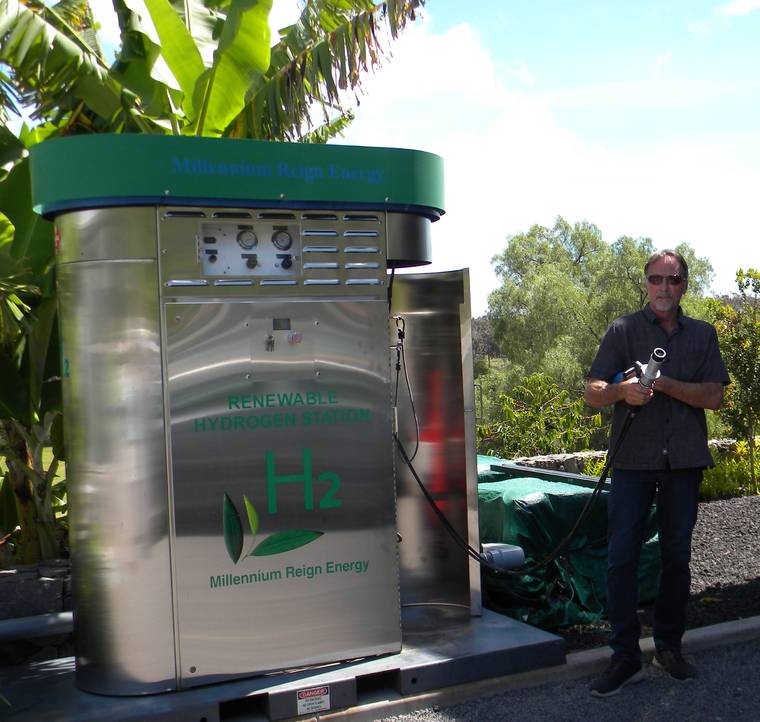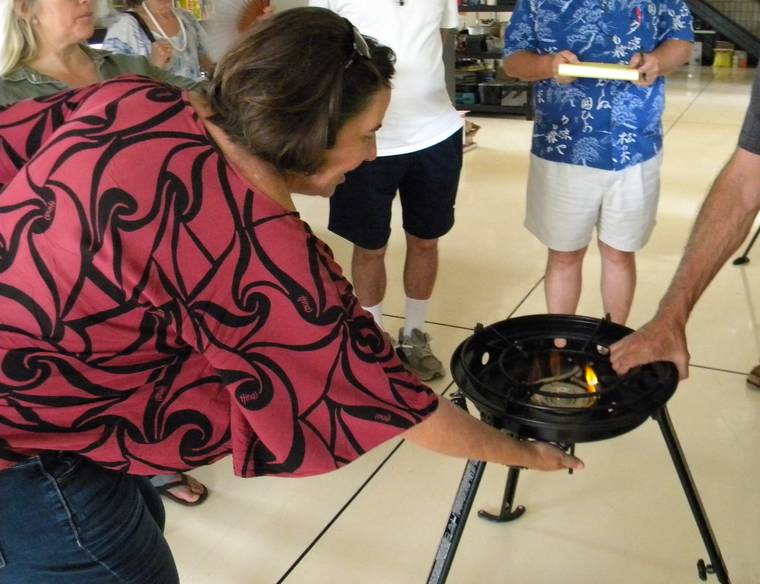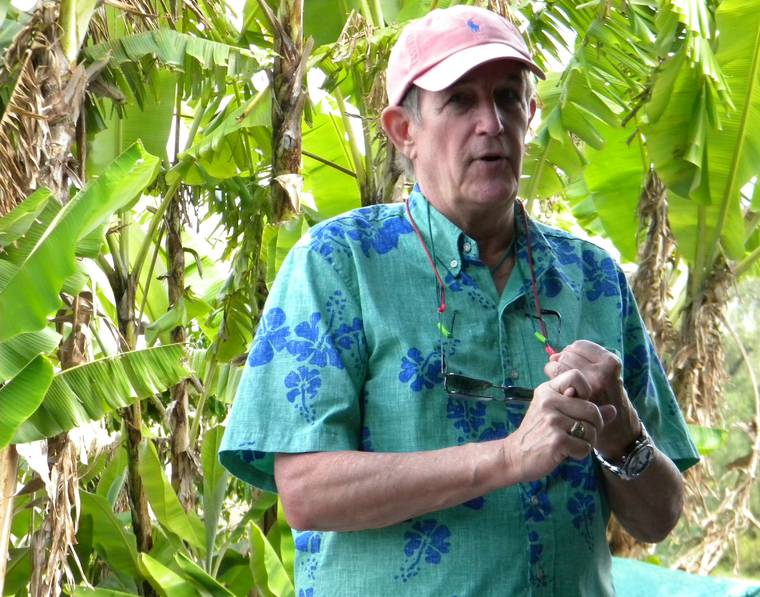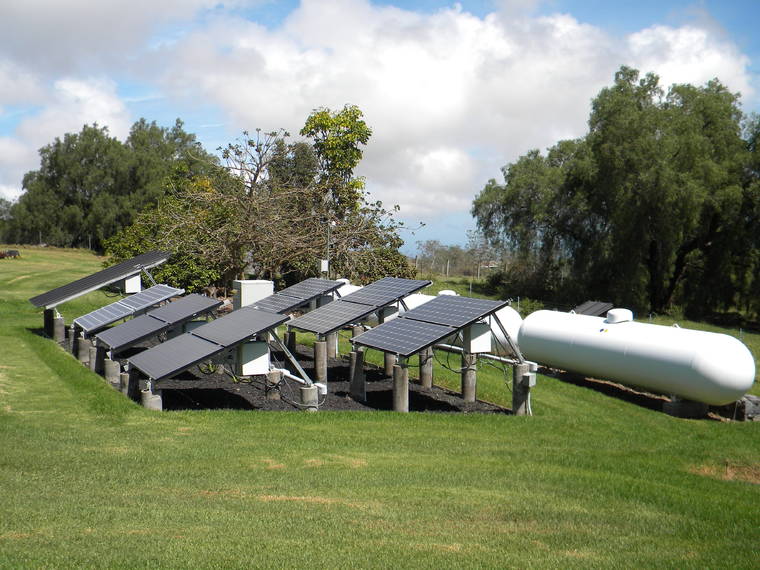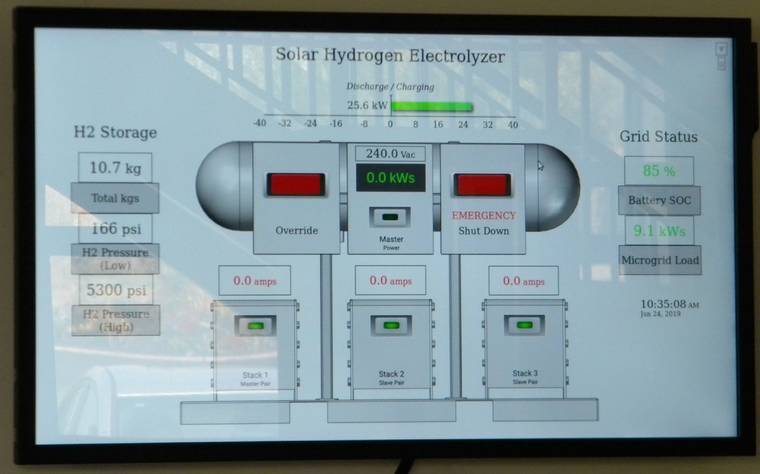Inside island’s hydrogen future: Researchers at Rogers’ Puu Waawaa ranch explore top energy solutions
PUU WAAWAA — Tucked among the old-time paniolo ranches in North Kona is a cutting-edge ranch of a different kind.
The Puu Waawaa energy ranch, the brainchild of visionary video-game developer and entrepreneur Henk Rogers, is an off-grid laboratory devoted to testing and developing renewable energy systems.
Rogers, the founder of the Blue Planet Foundation, is pushing to make the state’s energy use 100% renewable by 2045, ending the state’s reliance on fossil fuels that Rogers says is acidifying the ocean and killing the coral reef.
Rogers, who also has an off-grid home in Honolulu’s Round Top neighborhood, wasn’t in residence at the 32-acre ranch during a tour Monday. But Paul Ponthieux, director and chief technology officer of Blue Planet Research, was quick to take up the torch.
The word of the day is hydrogen.
Hydrogen to run the vehicles, to store the energy harnessed by the solar panels, to power the community water system, to create jobs, to cook the food. And to power the county’s Hele-On bus system.
Those in traffic behind a hydrogen-powered bus will find it quieter and much less stinky than its diesel-powered counterpart. In fact, the exhaust from a hydrogen bus is nothing but a little water vapor, proponents say.
Solar plus hydrogen is Blue Planet’s vision for the island’s future. Because solar is an intermittent power source, it’s important to be able to store the energy to use during off-peak hours. There’s usually 3.8 hours of quality sunshine in the mornings at the ranch, but the sky clouds over as the day progresses.
“We knew storage was important and the key,” Ponthieux said. “We have to grab all our energy in the limited window.”
The solar energy is used for electrolysis — passing an electric current through water to create hydrogen gas and oxygen. The hydrogen is then stored under pressure in energy cells, similar to a battery. Blue Planet prefers lithium ferrous phosphate over the lithium cobalt used by some storage cell manufacturers.
The lithium ferrous (or iron) phosphate is more environmentally conscious because it contains no rare earth metals and breaks down into a substance similar to olivine, the major component of the green sand beach. It’s also safer because it’s much less combustible, said Ponthieux.
And it doesn’t rely on child laborers mining the cobalt in the Congo. Ponthieux called the cobalt-based cells “blood electrons,” likening them to the better-known moniker “blood diamonds” for the mineral mined under similar circumstances.
There’s a chicken and egg problem with hydrogen for vehicles, said Mitch Ewan, hydrogen systems program manager of the Hawaii Natural Energy Institute at the University of Hawaii at Manoa. The vehicles need hydrogen fueling stations, while the fueling stations can’t be economically constructed without an assured customer base.
That’s where the government comes in.
The state Legislature this year passed HB 401, which would allow government agencies, including counties, to enter partnerships with private-sector energy transportation companies that would have the private company build the infrastructure based on a performance contract the government would pay over time. Gov. David Ige signed the bill Wednesday.
The county’s Hele-On bus system is a perfect candidate for this, Ewan said. The ZEB project, an acronym for zero-emission buses, would continue the county’s recent move to add three hydrogen buses to its fleet. Ewan visualizes a facility right on the island where mechanics would be trained to retrofit the old diesel buses so they’d use hydrogen instead.
If four or five hydrogen fuel stations were constructed at points around the island, the county buses and early adopters of the new technology would have a fueling spot. The system would be scalable as the demand grows, he said.
“The idea is use the public transportation to prime the pump and get the infrastructure in place and help people learn about hydrogen,” Ewan said.
State Sen. Lorraine Inouye, a North Hawaii Democrat who chairs the Senate Transportation Committee and sits on the Energy, Economic Development and Tourism Committee, sponsored the companion bill. She said Wednesday the Big Island is an ideal candidate for alternative energy options, but the county has been slow to act, not taking advantage of grants and other opportunities.
The struggling Hele-On system is a perfect example, she said. The county missed opportunities to get in on the ground floor with alternative fuel vehicles, but she thinks there’s still time to get on-board.
She said every administration has different priorities, and recent action by the Mayor Harry Kim administration seems to be whittling away at problems inherited from the past administration.
“We should have already been on the forefront,” Inouye said. “We don’t have a good transportation system. The county has got to come up with their plans.”
Among those touring the energy lab Monday was Heather Kimball, a Papaikou consultant who’d run unsuccessfully against Inouye last year. Kimball, a former research scientist at Lawrence Berkeley National Lab, said it wasn’t her first trip to the energy ranch, but she learns something new each time.
“I think hydrogen can potentially be a strong part of our reduce-carbon future,” Kimball said. “We have 11 years to cut our emissions in half and we can’t overlook any tool that can get us there.”
Ponthieux agrees. Hydrogen has certain advantages over electric vehicles, but both have huge advantages over fossil fuel, he said.
“We need both. There’s no silver bullet,” he said. “We have what we call ‘silver buckshot.’”
The caption on a photo in this article has been clarified to read: Paul Ponthieux, director and chief technology officer for Blue Planet Research, shows off the 1 megawatt hour battery storage system Monday on the Puu Waawaa energy ranch.

